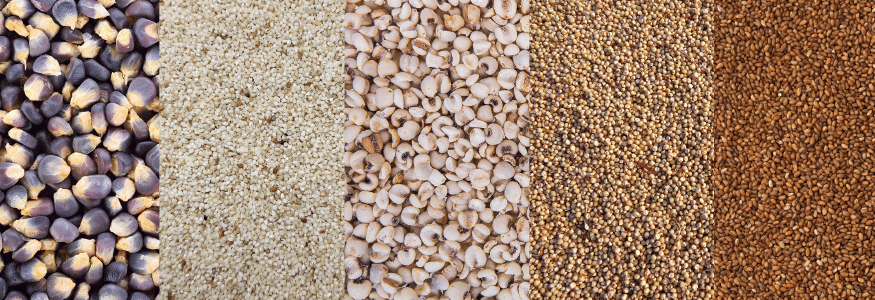
Five Gluten-Free Grains You Might Not Have Tried
Grains are nutritious energy-dense staples for countries all around the world, and this includes gluten-free grains such as rice, corn, and sorghum. Many of us tend to eat the same grains all the time, and yet there are so many to choose from. This article will discuss five gluten-free grains you’ve probably never tried, including their nutrition potential and how to make them easier to digest. If you’re tired of making quinoa and rice all the time, there are plenty of other options to choose from. If you want to experiment and try something new, it’s time to challenge yourself to try one of these gluten-free grains today.
Nutrition
You can get plenty of nutrients from grains, including protein, fibre, healthy fats, antioxidants, vitamins (e.g., thiamin, riboflavin, niacin), and minerals (e.g., calcium, magnesium, zinc, iron). Can you get these nutrients elsewhere? Of course, but eating whole grains is an efficient, healthy, and affordable way to get a vast number of them, especially if you eat a predominantly plant-based diet. As with any food, variety is key. I encourage eating a variety of whole grains to maximize the type and amounts of nutrients you get on a regular basis. It could mean that you eat rolled oats and buckwheat one week, followed by quinoa and sorghum the next. It can be interesting and fun to try different types.
Digestion
Do you have trouble digesting grains? There are ways you can process grains to make them easier to digest and even more nutritious, such as soaking them overnight or fermenting them. I highly encourage trying these methods, as you may find that you have no trouble digesting grains after all. This explains why 100% sourdough wheat bread, which is a fermented food, is easier to digest than commercial wheat bread, which is not a fermented food.
Fermentation is the pre-digestion of food by bacteria and their enzymes. This food processing method breaks down compounds that are difficult to digest and can make nutrients more available for our bodies to absorb.1 Grains naturally contain phytates, which bind to minerals like iron and calcium, reducing our body’s ability to absorb them. Soaking grains helps activate enzymes like phytase, which will break down the bond between phytate and the mineral to which it’s bound. This releases the mineral so that it is free to be absorbed by the intestine instead. Phytates are not all bad though, and science shows that if you are getting well-balanced nutrition, you are unlikely to become deficient in minerals simply from eating phytates. This only seems to be a problem if you are not eating enough food or are eating a nutrient-poor diet. Phytates have benefits, and although high quality human studies are needed to confirm these positive effects, they have been found to act as antioxidants, have anti-cancer effects, and prevent the calcification of tissue that can lead to heart disease.2
1. Blue Cornmeal
 Blue cornmeal originally comes from Peru, but it is also produced in Mexico and the United States. What makes blue corn special is that it is rich in anthocyanins, which are healthy active plant chemicals with antioxidant activity.3 Antioxidants are great in that they protect our cells from damage and may help prevent cancer. Blue and red fruits and vegetables like blueberries and beets also contain anthocyanins. One cup of blue cornmeal contains twelve grams of protein and ten grams of fibre. It also contains healthy fats, such as oleic acid, the same healthy fat found in olive and avocado oil. Have fun experimenting with blue corn, because the more antioxidants, the better!
Blue cornmeal originally comes from Peru, but it is also produced in Mexico and the United States. What makes blue corn special is that it is rich in anthocyanins, which are healthy active plant chemicals with antioxidant activity.3 Antioxidants are great in that they protect our cells from damage and may help prevent cancer. Blue and red fruits and vegetables like blueberries and beets also contain anthocyanins. One cup of blue cornmeal contains twelve grams of protein and ten grams of fibre. It also contains healthy fats, such as oleic acid, the same healthy fat found in olive and avocado oil. Have fun experimenting with blue corn, because the more antioxidants, the better!
Recipe Inspiration:
- blue polenta
- blue corn tortillas
- blue corn blueberry muffins
2. Fonio (a.k.a. acha, ‘hungry rice’, podgi)
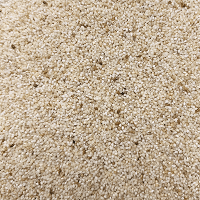 Fonio is an ancient grain from West Africa, predominantly grown in Mali, Senegal, Benin, and Guinea. It is often eaten as a porridge or as a steamed ‘couscous’. It is a very small white or black grain that has a mild nutty flavour.4 You can keep it simple and use fonio just as you would rice or quinoa. The Canadian Nutrient File and the USDA food database have not yet analyzed fonio at the time of writing this article. Third-party nutrient analysis from fonio supplier, Farafena Health, indicates fonio is gluten-free, approximately 7.5% protein, sugar-free, and a source of zinc and iron. It is also a good source of fibre.
Fonio is an ancient grain from West Africa, predominantly grown in Mali, Senegal, Benin, and Guinea. It is often eaten as a porridge or as a steamed ‘couscous’. It is a very small white or black grain that has a mild nutty flavour.4 You can keep it simple and use fonio just as you would rice or quinoa. The Canadian Nutrient File and the USDA food database have not yet analyzed fonio at the time of writing this article. Third-party nutrient analysis from fonio supplier, Farafena Health, indicates fonio is gluten-free, approximately 7.5% protein, sugar-free, and a source of zinc and iron. It is also a good source of fibre.
Recipe Inspiration:
- fonio banana bread
- fonio porridge
- fonio tabbouleh
3. Job’s Tears (a.k.a. coix seeds)
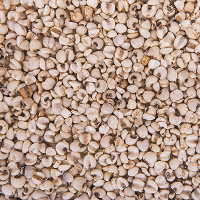 Job’s tears look a lot like pearl barley, but they are not the same thing. This grain is grown in China, Malaysia, India, Pakistan, and Sri Lanka. It is considered a nutritious health food in Asian countries but remains a mystery to many of us here in Canada. They come in a variety of colors: yellow, brown, white, and purple. Preliminary evidence shows that they may help lower cholesterol and blood sugar, which is likely due to their high fibre content.5
Job’s tears look a lot like pearl barley, but they are not the same thing. This grain is grown in China, Malaysia, India, Pakistan, and Sri Lanka. It is considered a nutritious health food in Asian countries but remains a mystery to many of us here in Canada. They come in a variety of colors: yellow, brown, white, and purple. Preliminary evidence shows that they may help lower cholesterol and blood sugar, which is likely due to their high fibre content.5
Recipe Inspiration:
- Job’s tears salad
- Job’s tears soup
- Job’s tears stew
4. Sorghum (a.k.a. milo or broom corn)
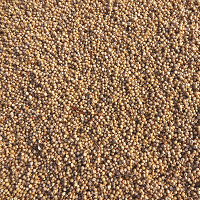 Sorghum is a round red or white grain that comes from central Africa.6 It is a staple in Sudan, where it can be used to make a fermented porridge, a non-alcoholic cereal beverage called kunu, and a paper-thin sourdough pancake called kissra, which is on my personal list of foods to try soon.7 One cup of sorghum contains around twenty grams of protein and twelve grams of fibre.8 You can also have some fun popping sorghum in a saucepan to make a tiny version of popcorn, which you can eat on its own or to add crunch to a salad or Buddha bowl.
Sorghum is a round red or white grain that comes from central Africa.6 It is a staple in Sudan, where it can be used to make a fermented porridge, a non-alcoholic cereal beverage called kunu, and a paper-thin sourdough pancake called kissra, which is on my personal list of foods to try soon.7 One cup of sorghum contains around twenty grams of protein and twelve grams of fibre.8 You can also have some fun popping sorghum in a saucepan to make a tiny version of popcorn, which you can eat on its own or to add crunch to a salad or Buddha bowl.
Recipe Inspiration:
- kissra (thin sourdough pancake)
- sorghum popcorn
- sorghum risotto
5. Teff
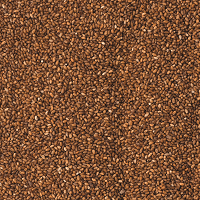 Teff comes from Ethiopia and it is the smallest grain in the world. It can be ground into flour or fermented into a flavourful sourdough flatbread called injera. One cup of teff grain has about twenty grams of protein and ten grams of fibre.9 It has a mild nutty taste and can be found in different colors: white, black, red, and brown. I have made injera several times and love it with a good spicy chickpea curry. Injera is only gluten-free if it is made with 100% teff flour. Many North American restaurants make it with a mix of flours (wheat, barley), so be sure to ask if you follow a gluten-free diet. If you haven’t tried making injera yet, it’s pretty easy to make, and you can refrigerate it for use during the week.
Teff comes from Ethiopia and it is the smallest grain in the world. It can be ground into flour or fermented into a flavourful sourdough flatbread called injera. One cup of teff grain has about twenty grams of protein and ten grams of fibre.9 It has a mild nutty taste and can be found in different colors: white, black, red, and brown. I have made injera several times and love it with a good spicy chickpea curry. Injera is only gluten-free if it is made with 100% teff flour. Many North American restaurants make it with a mix of flours (wheat, barley), so be sure to ask if you follow a gluten-free diet. If you haven’t tried making injera yet, it’s pretty easy to make, and you can refrigerate it for use during the week.
Recipe Inspiration:
- injera (fermented Ethiopian flatbread)
- teff porridge
- teff risotto
Conclusion
Whole, gluten-free grains are nutritious and versatile, and there are many to choose from. They can be made easier to digest through soaking and fermentation, food processing techniques that are used by many cultures around the world. If you have tried some or all of the gluten-free grains listed above, good for you! Other gluten-free grains you may not have tried are kaniwa, buckwheat, amaranth, forbidden rice, or Himalayan red rice. I challenge you to bring something other than a quinoa salad to your next social gathering.
Anne-Marie Stelluti, RD
First published in the Inside Tract® newsletter issue 210 – 2019
Photos: Blue Corn © Deenida|Shutterstock; Fonio © Farafena; Coix Seeds © Subin Pumsom|Bigstockphoto; Sorghum © Vijaya narasimha|Pixabay; Teff © raptorcaptor|123RF.
1. Katz SE. The Art of Fermentation. White River Junction, Vermont: Chelsea Green Publishing; 2012.
2. Schlemmer et al. Phytate in foods and significance for humans: Food sources, intake, processing, bioavailabilty, protective role and analysis. Mol. Nutr. Food Res. 2009; 53: 330-375.
3. Mutlu et al. Physicochemical, Thermal, and Sensory Properties of Blue Corn (Zea Mays L.). J. Food Sci. 2019; 83: 53-59.
4. Glew et al. Fatty acid, amino acid, mineral and antioxidant contents of acha (Digitaria exilis) grown on the Jos Plateau, Nigeria. Int J Nutr Metab. 2013; 5: 1-8.
5. Natural Medicines Database. Job’s tears. Available at https://naturalmedicines-therapeuticresearch-com. Accessed 2019-05-17.
6. Natural Medicines Database. Broom corn. Available at https://naturalmedicines-therapeuticresearch-com. Accessed 2019-05-17.
7. Katz SE. The Art of Fermentation. White River Junction, Vermont: Chelsea Green Publishing; 2012.
8. USDA food database. Sorghum. Available at https://ndb.nal.usda.gov/ndb/. Accessed 2019-05-17
9. Case S. Gluten-Free Diet: A Comprehensive Resource Guide-Expanded and Revised Edition. Case Nutrition Consulting Inc; 2010.

